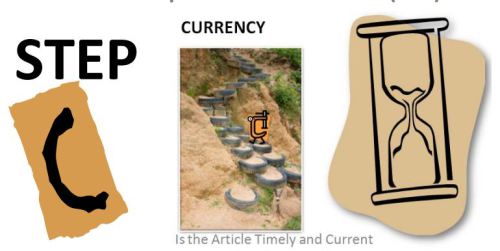Step C: Seven Steps To Website Evaluation For Students - Promoting Digital Citizens/Currency

I believe that web evaluation must be a simple process that can also be applied to memory. Thus the reason for my (A-G) approach. This series is devoted to teaching these skills and I have spent hours preparing resources that you are free to use. I have divided this series using my A-G approach. It really is time to help kids understand that there are no whales in Lake Michigan, the Southwest Tree Octopus is nonexistent, study of cats and bearded men did not really happen, moon creatures failed to film the lunar landing, and Columbus was not born in Australia. Please enjoy, share, and use! You can also explore prior posts in this series.
- Step A… Seven Steps To Website Evaluation For Students… Promoting Digital Citizens
- Step B… Seven Steps To Website Evaluation For Students… Promoting Digital Citizens
C Is For Currency
Currency refers to the date which an article was published. A researcher must remember that there may be several dates on the web site. These may even include the web site’s date of origin and a web site date of update. In other words, when the web site was first created and when it was last updated. These dates may be totally different from the date an article is posted on the web site it resides on. Proper research demands that one know the difference. There may even be times when the article or web site has not listed a formal date. In this case, one may have to find hints of publication date by scanning the article. Last, it must be determined if currency is relevant to the research at hand. Let’s explore this topic further by highlighting three important factors.
1. Date of Article – This refers to the date the article being considered for research was published or possibly last updated. Do not get this confused with the web page itself, unless the web site is to be considered the article in question. One example may include an article written by Alexander Graham Bell in reference to the invention of the telephone. Such an article may be hosted on a web site called “Great Inventors” which was published in 2000 and last updated in 2010. Since the article was written by Bell it could not have been published on the same dates as web site creation or even the site’s last up-date. In fact,further research may reveal that it was actually a reprint of an article found in Pre Cell Phone Magazine published in 1878. The correct date for the article needed for research would be listed as 1878. There may be circumstances when a date cannot be found. In this case one may have to estimate the date from reading the article. In the case of this article, since it was written by Bell after he invented the telephone it would have to be estimated between 1876 (telephone invention) and 1922 (Bell’s death). The article itself may give multiple hints.
2. Updates to Site – A vibrant and ongoing web site regarding a particular topic may list multiple updates to the topic being researched. If one is researching the history of the telephone,the website Telephone: an Amazing Life,may contain multiple articles with new ones constantly being added. Or, it may actually be one large entry that is constantly updated in order to keep current. In either case, it is important to be aware of both the article’s dates, and the possible dates on which a large entry was updated. A review of Wikipedia allows the user to ask for the latest update by using View History at the top of the page. In the case of the telephone,Wikipedia has usually had an update to the site within any given 24 hour period. Another way to view an entire website with regard to its history is to submit the web site address to the Waybackmachine (http://www.archive.org/web/web.php). At this site one can view the updates to a web site from 1996 to the last few months.
3. Importance of Currency – A researcher must determine if the currency of an article or web site is relevant for the research being performed. In some cases the most current information must be found and, in other cases, primary sources giving an eyewitness account may be more desirable. It comes down to the needs of the researcher. A person desiring the personal
accounts of Alexander Graham Bell as he walked through the steps of the telephone invention may be very interested in an article published in 1878. On the other hand, researchers dedicated to discovering repercussions of cell phone use and health may wish to
have the most recent article published. Covering a current event may require a researcher to stipulate date fields when performing an internet search. It is important to be aware of publication dates and how they relate to accurate and effective research.
Download Poster Here: c1_poster_info
Enjoying the series?… Please let me know by email, response, and sign up… and please share with a Retweet!
Tools and ideas to transform education. Sign up below.
cross-posted at 21centuryedtech.wordpress.com
Michael Gorman oversees one-to-one laptop programs and digital professional development for Southwest Allen County Schools near Fort Wayne, Indiana. He is a consultant for Discovery Education, ISTE, My Big Campus, and November Learning and is on the National Faculty for The Buck Institute for Education. His awards include district Teacher of the Year, Indiana STEM Educator of the Year and Microsoft’s 365 Global Education Hero. Read more at 21centuryedtech.wordpress.com.
